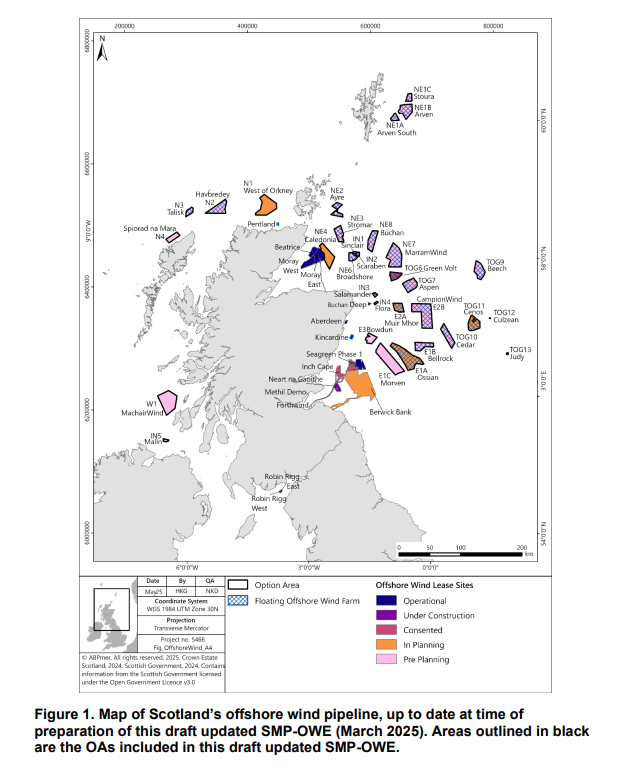The Scottish Government has updated a draft of the Sectoral Marine Plan for Offshore Wind Energy (SMP-OWE), marking a pivotal moment for the country’s clean energy ambitions. The update sets the strategic spatial framework for developing the ScotWind and INTOG leasing rounds, offering developers greater certainty, transparency and long-term planning clarity.
According to Energy Minister Gillian Martin, the plan is designed to balance sustainable development with environmental protections and socio-economic gains, and to serve as a blueprint for future marine energy infrastructure.
“This updated planning will allow us to unlock over 45 GW of offshore wind capacity by 2035, significantly contributing to our net zero targets, energy security and economic benefits,” states Minister Martin.
This revised vision is aligned with Scotland’s role as a key contributor to the UK’s 2030 Clean Power Plan and positions the country as a future green energy supplier to Europe.
Current pipeline: From seabed to supply chain
Scotland’s offshore wind market is growing rapidly. It currently hosts nine operational offshore wind farms, with a combined capacity of 2.973 MW, and several others under construction contributing a further 1.332 MW. These include:
-
Seagreen (1,075 MW): Scotland’s largest operational offshore wind farm, using some of the deepest fixed foundations globally.
-
Moray East (950 MW) and Moray West (882 MW): Developed in the Moray Firth, these projects power over 2 million homes.
-
Neart na Gaoithe (450 MW) and Inch Cape (1,080 MW): Under construction, with strong local supply chain engagement.
-
Berwick Bank (4,100 MW): One of the most ambitious in the UK pipeline.
-
Pentland (100 MW): Will be Scotland’s next floating wind project.
Scotland also leads in floating wind technology, with pioneering projects like Hywind Scotland (30 MW) and Kincardine (50 MW)—the latter being the world’s largest operational floating wind farm.
In addition, 20 GW were awarded under ScotWind in 2022, while the INTOG leasing round added 5.4 GW, focusing on powering oil and gas infrastructure and supporting technology trials.

A planning framework built on evidence and collaboration
The SMP-OWE update is informed by the latest scientific data, environmental assessments and stakeholder input. It identifies Areas of Search for future wind development, aiming to avoid ecologically sensitive zones, minimise impacts on marine users like fisheries, and streamline regulatory processes.
“This is a responsible plan that balances development, biodiversity and community needs,” says Minister Martin.
The draft plan is now open for public consultation until 22 August 2025, inviting responses from local communities, industry stakeholders and environmental groups.
Economic transformation through offshore wind
Offshore wind is expected to play a critical role in Scotland’s economic future. Each project could generate over £1.5 billion in domestic supply chain investment, according to commitments made in ScotWind leasing. The sector is forecast to support up to 22,000 direct jobs by 2030, particularly in construction, operations, engineering, and port logistics.
Additionally, projects are encouraged to submit Supply Chain Development Statements, a regulatory requirement ensuring that local content and skills development remain central to long-term planning.
“With this planning, Scotland consolidates its role as a green powerhouse in Europe,” emphasises Martin.
A resilient, low-carbon grid for the future
The plan also addresses the need for grid readiness. It aligns closely with the Holistic Network Design (HND) from the UK’s Electricity System Operator and future North Sea interconnections. The aim is to ensure secure, affordable and efficient integration of new capacity while avoiding bottlenecks.
“We are building the infrastructure for a clean, resilient and competitive energy system,” highlights Martin.
Environmental integrity and stakeholder trust
Environmental assessments conducted as part of the updated SMP-OWE include the Sustainability Appraisal, Habitat Regulations Appraisal, and Social and Economic Impact Assessment. These ensure the plan delivers on climate goals without compromising marine biodiversity or other critical ecosystem services.
Scotland also remains committed to inclusive engagement, particularly with coastal communities and indigenous industries, to ensure the transition to net zero is fair and equitable.































